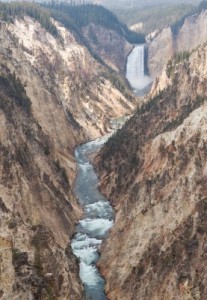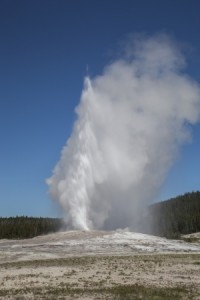
A grand canyon in Yellowstone National Park sits beneath a volcanic caldera.
Friday the 13th was an unlucky day for Yellowstone National Park, north of the famous geyser, Old Faithful.
Three earthquakes occurred within minutes of one another, and these were volcanic quakes, signaling the movement of magma beneath the Yellowstone caldera.
The Quakes
The earthquakes were small, but it’s where they were located that is of interest.
A 2.9 (I consider this a 3.0) quake was immediately followed by a 3.5 magnitude quake, and then by another 2.9 (3.0) quake on Friday morning.
You could almost “feel” the rumble from its churning, sour belly of hot magma.
The Caldera

Old Faithful erupting in Yellowstone National Park, Wyoming.
Given Yellowstone’s volcanic history and the continued presence of magma beneath the Yellowstone caldera, we cannot discount the possibility of an eruption occurring in the future.
The question everyone asks is “when?” No one knows the answer to this, but scientists do know that the last major eruption at Yellowstone was 400,000 years ago – just a blink in geologic time.
The History
Yellowstone’s 2-million-year history of volcanism mixed with the tremendous amount of heat that flows under Yellowstone today, reminds us that magma beneath Yellowstone can reach a point of volcanic activity anytime – especially when we continue to see more recent earthquakes.
Eruptions
The first signs of an eruption at the caldera will more than likely begin as steam blasts or hydrothermal increases in activity. These produce shallow reservoirs of steam or hot water rather than flows of molten rock. These are the sources of Yellowstone’s famous hot springs and geysers, like Old Faithful.
Then, we will begin to see small explosive eruptions that throw ash, pumice, and molten lava into the surrounding environment. The worst case scenario will be if another catastrophic caldera-forming eruption were to occur like it did 400,000 years ago.
For now, just watch for the earthquakes rumbling beneath this magnificent wildlife area, and when the steam begins to ramp up the geysers, start looking a bit more closely.
